University Essay: Naomi's Character Development in Joy Kogawa's Obasan
VerifiedAdded on 2022/08/21
|5
|1157
|13
Essay
AI Summary
This essay delves into the character of Naomi in Joy Kogawa's novel, 'Obasan,' focusing on her transformation throughout the narrative. The essay explores Naomi's personality, marked by silence and repression due to childhood traumas like displacement, internment, and abuse. It examines how these experiences shape her adult life and how she copes with the past, particularly through the influence of her Aunt Emily. The essay analyzes Naomi's journey of self-discovery, her struggle with silence, and her eventual understanding that silence doesn't always prevent communication, especially in the context of her relationship with her mother. Furthermore, the essay touches upon the historical context of the novel, highlighting the injustices faced by Japanese-Canadians and Naomi's resilience in the face of adversity. The essay concludes by emphasizing Naomi's growth and her ability to confront the past, ultimately changing her perspective.
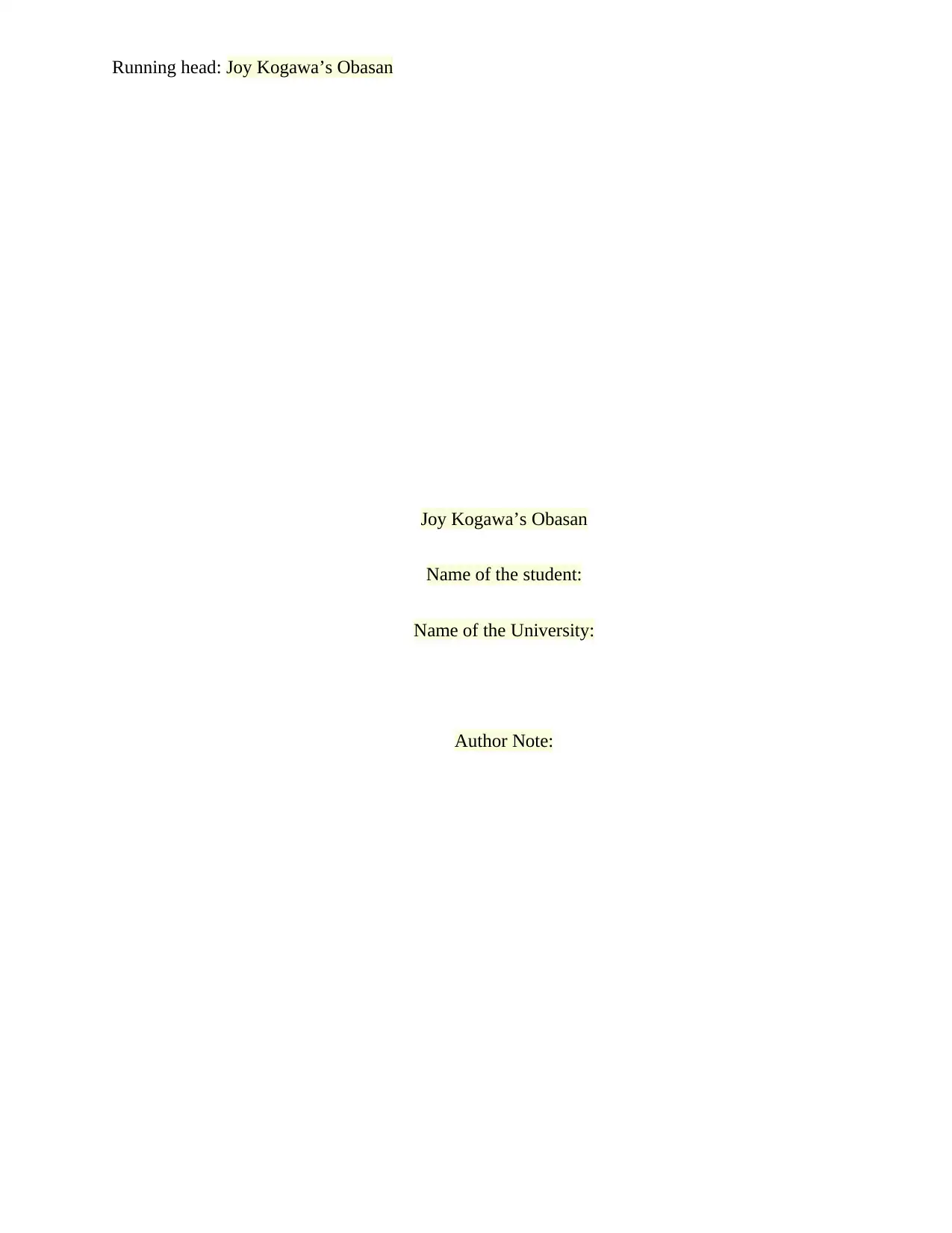
Running head: Joy Kogawa’s Obasan
Joy Kogawa’s Obasan
Name of the student:
Name of the University:
Author Note:
Joy Kogawa’s Obasan
Name of the student:
Name of the University:
Author Note:
Paraphrase This Document
Need a fresh take? Get an instant paraphrase of this document with our AI Paraphraser
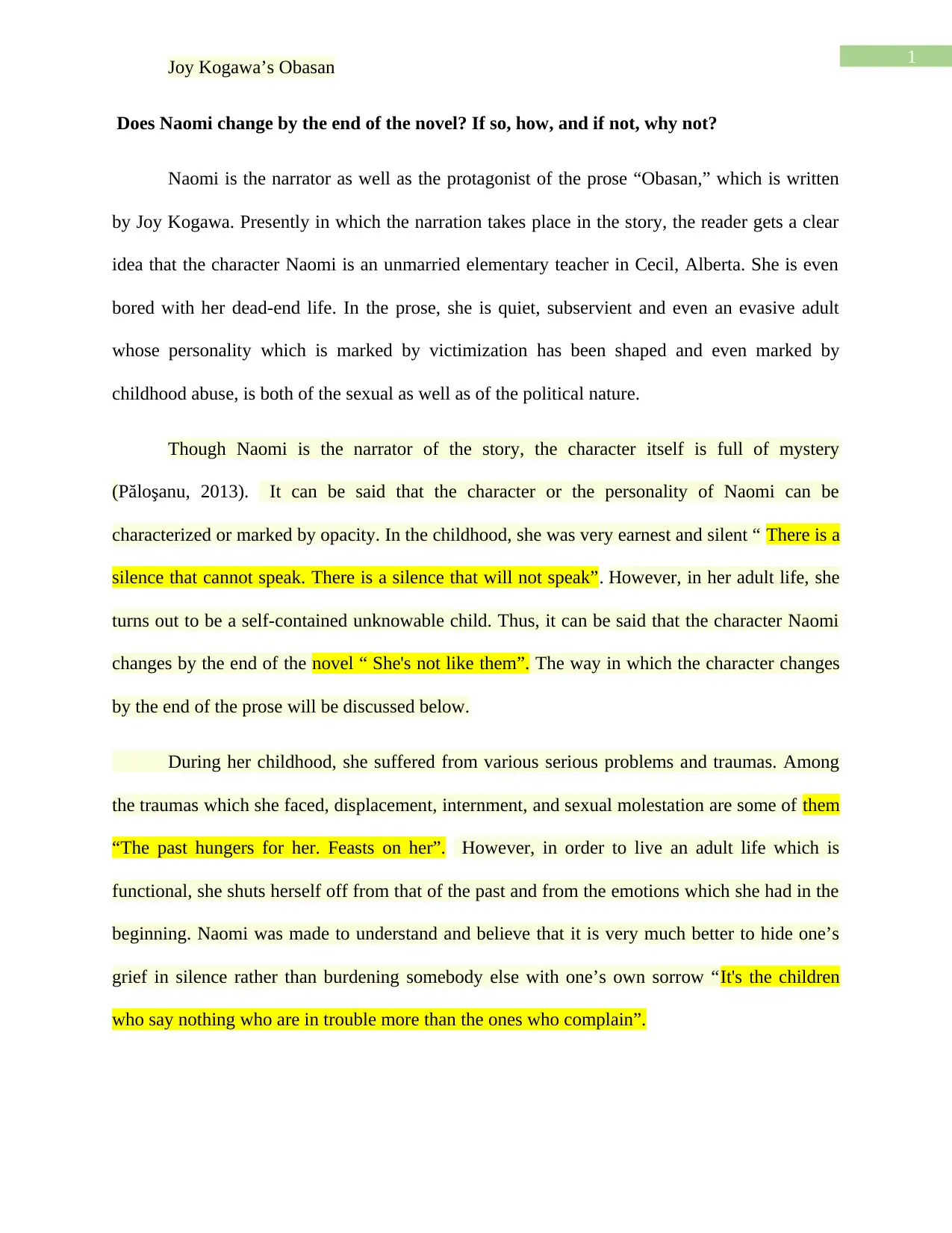
1
Joy Kogawa’s Obasan
Does Naomi change by the end of the novel? If so, how, and if not, why not?
Naomi is the narrator as well as the protagonist of the prose “Obasan,” which is written
by Joy Kogawa. Presently in which the narration takes place in the story, the reader gets a clear
idea that the character Naomi is an unmarried elementary teacher in Cecil, Alberta. She is even
bored with her dead-end life. In the prose, she is quiet, subservient and even an evasive adult
whose personality which is marked by victimization has been shaped and even marked by
childhood abuse, is both of the sexual as well as of the political nature.
Though Naomi is the narrator of the story, the character itself is full of mystery
(Păloşanu, 2013). It can be said that the character or the personality of Naomi can be
characterized or marked by opacity. In the childhood, she was very earnest and silent “ There is a
silence that cannot speak. There is a silence that will not speak”. However, in her adult life, she
turns out to be a self-contained unknowable child. Thus, it can be said that the character Naomi
changes by the end of the novel “ She's not like them”. The way in which the character changes
by the end of the prose will be discussed below.
During her childhood, she suffered from various serious problems and traumas. Among
the traumas which she faced, displacement, internment, and sexual molestation are some of them
“The past hungers for her. Feasts on her”. However, in order to live an adult life which is
functional, she shuts herself off from that of the past and from the emotions which she had in the
beginning. Naomi was made to understand and believe that it is very much better to hide one’s
grief in silence rather than burdening somebody else with one’s own sorrow “It's the children
who say nothing who are in trouble more than the ones who complain”.
Joy Kogawa’s Obasan
Does Naomi change by the end of the novel? If so, how, and if not, why not?
Naomi is the narrator as well as the protagonist of the prose “Obasan,” which is written
by Joy Kogawa. Presently in which the narration takes place in the story, the reader gets a clear
idea that the character Naomi is an unmarried elementary teacher in Cecil, Alberta. She is even
bored with her dead-end life. In the prose, she is quiet, subservient and even an evasive adult
whose personality which is marked by victimization has been shaped and even marked by
childhood abuse, is both of the sexual as well as of the political nature.
Though Naomi is the narrator of the story, the character itself is full of mystery
(Păloşanu, 2013). It can be said that the character or the personality of Naomi can be
characterized or marked by opacity. In the childhood, she was very earnest and silent “ There is a
silence that cannot speak. There is a silence that will not speak”. However, in her adult life, she
turns out to be a self-contained unknowable child. Thus, it can be said that the character Naomi
changes by the end of the novel “ She's not like them”. The way in which the character changes
by the end of the prose will be discussed below.
During her childhood, she suffered from various serious problems and traumas. Among
the traumas which she faced, displacement, internment, and sexual molestation are some of them
“The past hungers for her. Feasts on her”. However, in order to live an adult life which is
functional, she shuts herself off from that of the past and from the emotions which she had in the
beginning. Naomi was made to understand and believe that it is very much better to hide one’s
grief in silence rather than burdening somebody else with one’s own sorrow “It's the children
who say nothing who are in trouble more than the ones who complain”.
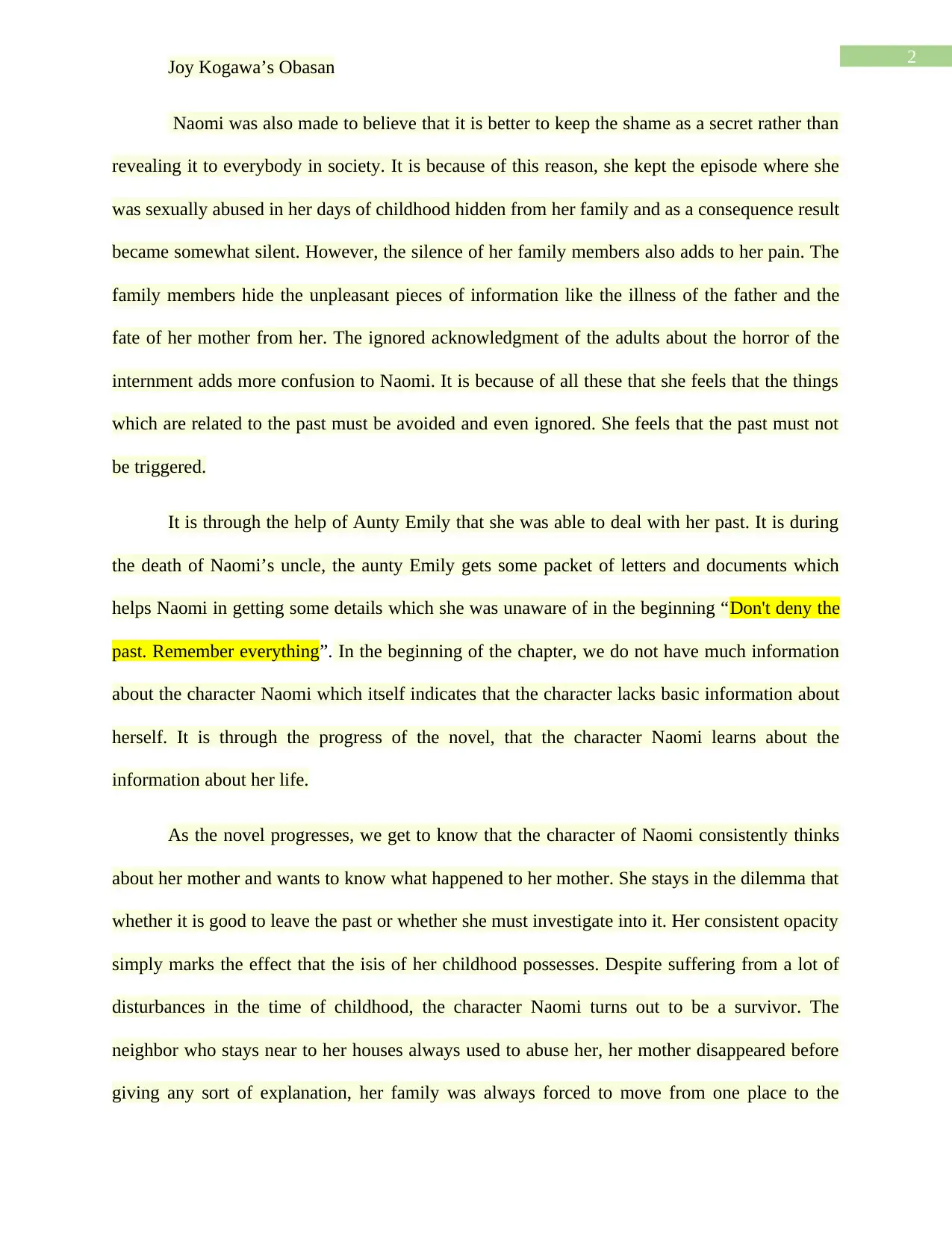
2
Joy Kogawa’s Obasan
Naomi was also made to believe that it is better to keep the shame as a secret rather than
revealing it to everybody in society. It is because of this reason, she kept the episode where she
was sexually abused in her days of childhood hidden from her family and as a consequence result
became somewhat silent. However, the silence of her family members also adds to her pain. The
family members hide the unpleasant pieces of information like the illness of the father and the
fate of her mother from her. The ignored acknowledgment of the adults about the horror of the
internment adds more confusion to Naomi. It is because of all these that she feels that the things
which are related to the past must be avoided and even ignored. She feels that the past must not
be triggered.
It is through the help of Aunty Emily that she was able to deal with her past. It is during
the death of Naomi’s uncle, the aunty Emily gets some packet of letters and documents which
helps Naomi in getting some details which she was unaware of in the beginning “Don't deny the
past. Remember everything”. In the beginning of the chapter, we do not have much information
about the character Naomi which itself indicates that the character lacks basic information about
herself. It is through the progress of the novel, that the character Naomi learns about the
information about her life.
As the novel progresses, we get to know that the character of Naomi consistently thinks
about her mother and wants to know what happened to her mother. She stays in the dilemma that
whether it is good to leave the past or whether she must investigate into it. Her consistent opacity
simply marks the effect that the isis of her childhood possesses. Despite suffering from a lot of
disturbances in the time of childhood, the character Naomi turns out to be a survivor. The
neighbor who stays near to her houses always used to abuse her, her mother disappeared before
giving any sort of explanation, her family was always forced to move from one place to the
Joy Kogawa’s Obasan
Naomi was also made to believe that it is better to keep the shame as a secret rather than
revealing it to everybody in society. It is because of this reason, she kept the episode where she
was sexually abused in her days of childhood hidden from her family and as a consequence result
became somewhat silent. However, the silence of her family members also adds to her pain. The
family members hide the unpleasant pieces of information like the illness of the father and the
fate of her mother from her. The ignored acknowledgment of the adults about the horror of the
internment adds more confusion to Naomi. It is because of all these that she feels that the things
which are related to the past must be avoided and even ignored. She feels that the past must not
be triggered.
It is through the help of Aunty Emily that she was able to deal with her past. It is during
the death of Naomi’s uncle, the aunty Emily gets some packet of letters and documents which
helps Naomi in getting some details which she was unaware of in the beginning “Don't deny the
past. Remember everything”. In the beginning of the chapter, we do not have much information
about the character Naomi which itself indicates that the character lacks basic information about
herself. It is through the progress of the novel, that the character Naomi learns about the
information about her life.
As the novel progresses, we get to know that the character of Naomi consistently thinks
about her mother and wants to know what happened to her mother. She stays in the dilemma that
whether it is good to leave the past or whether she must investigate into it. Her consistent opacity
simply marks the effect that the isis of her childhood possesses. Despite suffering from a lot of
disturbances in the time of childhood, the character Naomi turns out to be a survivor. The
neighbor who stays near to her houses always used to abuse her, her mother disappeared before
giving any sort of explanation, her family was always forced to move from one place to the
⊘ This is a preview!⊘
Do you want full access?
Subscribe today to unlock all pages.

Trusted by 1+ million students worldwide
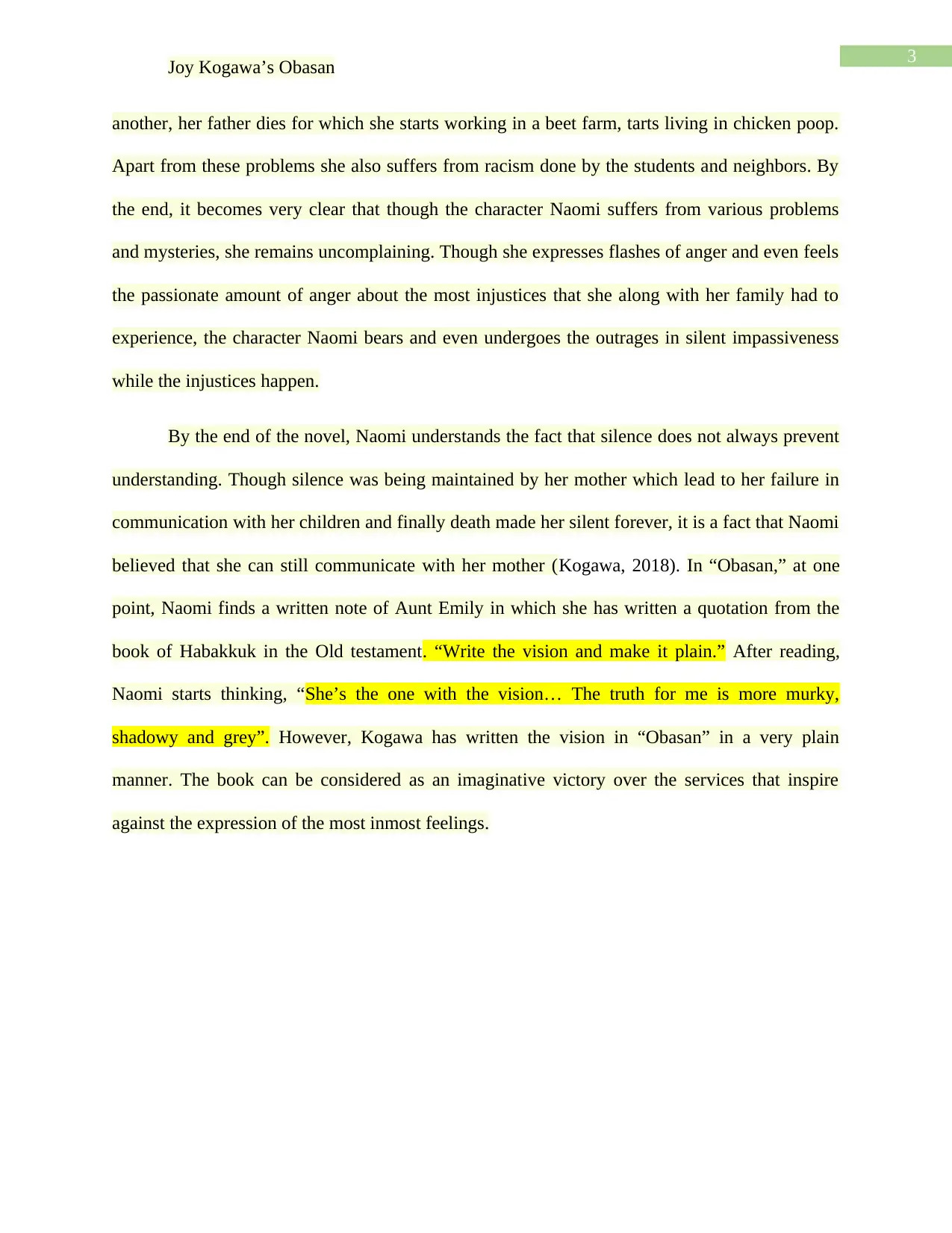
3
Joy Kogawa’s Obasan
another, her father dies for which she starts working in a beet farm, tarts living in chicken poop.
Apart from these problems she also suffers from racism done by the students and neighbors. By
the end, it becomes very clear that though the character Naomi suffers from various problems
and mysteries, she remains uncomplaining. Though she expresses flashes of anger and even feels
the passionate amount of anger about the most injustices that she along with her family had to
experience, the character Naomi bears and even undergoes the outrages in silent impassiveness
while the injustices happen.
By the end of the novel, Naomi understands the fact that silence does not always prevent
understanding. Though silence was being maintained by her mother which lead to her failure in
communication with her children and finally death made her silent forever, it is a fact that Naomi
believed that she can still communicate with her mother (Kogawa, 2018). In “Obasan,” at one
point, Naomi finds a written note of Aunt Emily in which she has written a quotation from the
book of Habakkuk in the Old testament. “Write the vision and make it plain.” After reading,
Naomi starts thinking, “She’s the one with the vision… The truth for me is more murky,
shadowy and grey”. However, Kogawa has written the vision in “Obasan” in a very plain
manner. The book can be considered as an imaginative victory over the services that inspire
against the expression of the most inmost feelings.
Joy Kogawa’s Obasan
another, her father dies for which she starts working in a beet farm, tarts living in chicken poop.
Apart from these problems she also suffers from racism done by the students and neighbors. By
the end, it becomes very clear that though the character Naomi suffers from various problems
and mysteries, she remains uncomplaining. Though she expresses flashes of anger and even feels
the passionate amount of anger about the most injustices that she along with her family had to
experience, the character Naomi bears and even undergoes the outrages in silent impassiveness
while the injustices happen.
By the end of the novel, Naomi understands the fact that silence does not always prevent
understanding. Though silence was being maintained by her mother which lead to her failure in
communication with her children and finally death made her silent forever, it is a fact that Naomi
believed that she can still communicate with her mother (Kogawa, 2018). In “Obasan,” at one
point, Naomi finds a written note of Aunt Emily in which she has written a quotation from the
book of Habakkuk in the Old testament. “Write the vision and make it plain.” After reading,
Naomi starts thinking, “She’s the one with the vision… The truth for me is more murky,
shadowy and grey”. However, Kogawa has written the vision in “Obasan” in a very plain
manner. The book can be considered as an imaginative victory over the services that inspire
against the expression of the most inmost feelings.
Paraphrase This Document
Need a fresh take? Get an instant paraphrase of this document with our AI Paraphraser
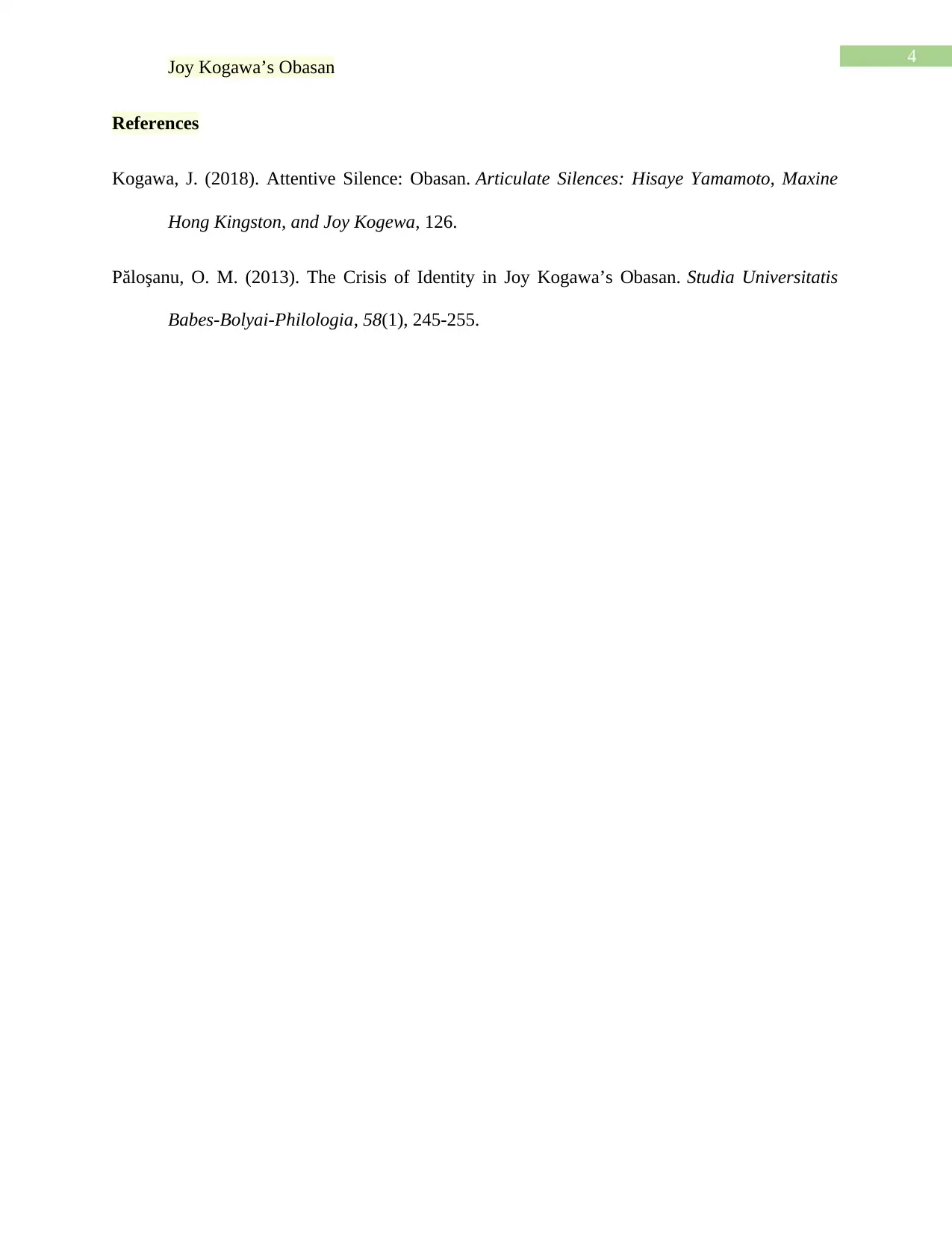
4
Joy Kogawa’s Obasan
References
Kogawa, J. (2018). Attentive Silence: Obasan. Articulate Silences: Hisaye Yamamoto, Maxine
Hong Kingston, and Joy Kogewa, 126.
Păloşanu, O. M. (2013). The Crisis of Identity in Joy Kogawa’s Obasan. Studia Universitatis
Babes-Bolyai-Philologia, 58(1), 245-255.
Joy Kogawa’s Obasan
References
Kogawa, J. (2018). Attentive Silence: Obasan. Articulate Silences: Hisaye Yamamoto, Maxine
Hong Kingston, and Joy Kogewa, 126.
Păloşanu, O. M. (2013). The Crisis of Identity in Joy Kogawa’s Obasan. Studia Universitatis
Babes-Bolyai-Philologia, 58(1), 245-255.
1 out of 5
Your All-in-One AI-Powered Toolkit for Academic Success.
+13062052269
info@desklib.com
Available 24*7 on WhatsApp / Email
![[object Object]](/_next/static/media/star-bottom.7253800d.svg)
Unlock your academic potential
Copyright © 2020–2025 A2Z Services. All Rights Reserved. Developed and managed by ZUCOL.


